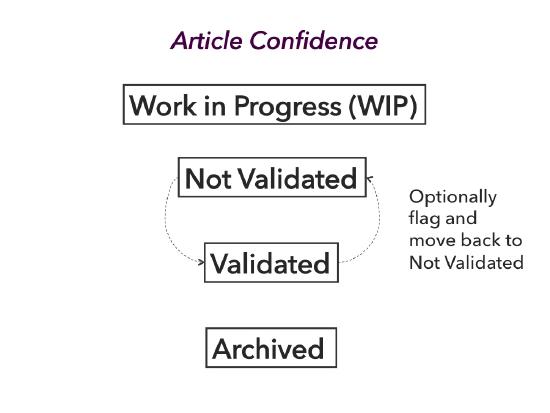KCS Article Template
Contributors Summary (This Page)
User Edits Comments Labels Last Update James Lewis 1 2 0 2043 days ago
Page Info
Viewtracker Report
Viewtracker
Metadata - The article also contains a collection of attributes that describe a variety of things about the article. Some of these attributes are added by the knowledge management system automatically, like dates, time stamps, versions, reuse counts, and the identity of the knowledge worker(s) that created or have modified the article. Other attributes are explicitly set by the knowledge worker as the article is created and used. This includes the visibility, quality, and governance attributes.
| Audience |
|
|---|---|
| Breadcrumb | |
| Permalink | https://utexas.atlassian.net/wiki/x/yYyaB |
| Confidence |
|
| Visibility | INTERNAL - Only an audience internal to an organization will be able to see the article. Note: anything with wider visibility than Internal is referred to as External. WITHIN A DOMAIN - A group associated with a particular product domain, topic, job function, department etc. PARTNERS - Someone who is not an employee but acts as a trusted extension of the organization. CUSTOMERS - Customers or users of our products or services . These articles typically are made accessible via a web-based self-service portal for registered users. PUBLIC -The KCS article is intended for anyone unidentified in the public domain. A common practice is to have this article optimized and indexed for a publicly available search appliance like Google. |
| Governance | Experience Based - The Experience Based attribute is the most open level of governance, and control is a function of being a member of the community and having an identity. Sign-in is required. The number of people with this level of rights and privileges will be very large; they can create and modify articles with the Collective attribute. The individual's KCS license level defines their rights and privileges in setting the visibility attribute (Internal, Partner, External) and the confidence attribute (Not Validated, Validated) Compliance Based - The Compliance Based attribute is restrictive, in that only designated individuals or specific groups of individuals can create and modify articles with the Compliance attribute. These articles contain information that describes policy, regulatory, or legal information. While everyone should be able to comment on all types of articles, not everyone can create or modify articles with the Compliance attribute. |
| Issue | Issue (symptom, problem, or question)—the issue is described in the requestor's words and phrases—what are they trying to do, what is not working, or what are they are looking for? It is helpful to view this field as belonging to the requestor (even though it may be captured by the responder). It must represent the requestor's perspective and context. |
|---|---|
| Environment | Environment—what product(s), category, or business process does the requestor have? Has anything been changed recently, such as upgrades, additions, deletions? The environment description should be as precise as possible, with standard ways to document product names, versions, or processes. The environment will remain the same after the issue is resolved. |
| Resolution | Resolution—the answer or the steps taken to resolve the issue. |
| Cause | Cause—the underlying cause of the issue. Cause is an optional field as it is not appropriate or necessary for some types of articles. A simple Q&A, for example, doesn't need a cause. However for complex technical issues, a cause can be very helpful in assisting the user in determining if an article is relevant to them. |

Welcome to the University Wiki Service! Please use your IID (yourEID@eid.utexas.edu) when prompted for your email address during login or click here to enter your EID. If you are experiencing any issues loading content on pages, please try these steps to clear your browser cache.